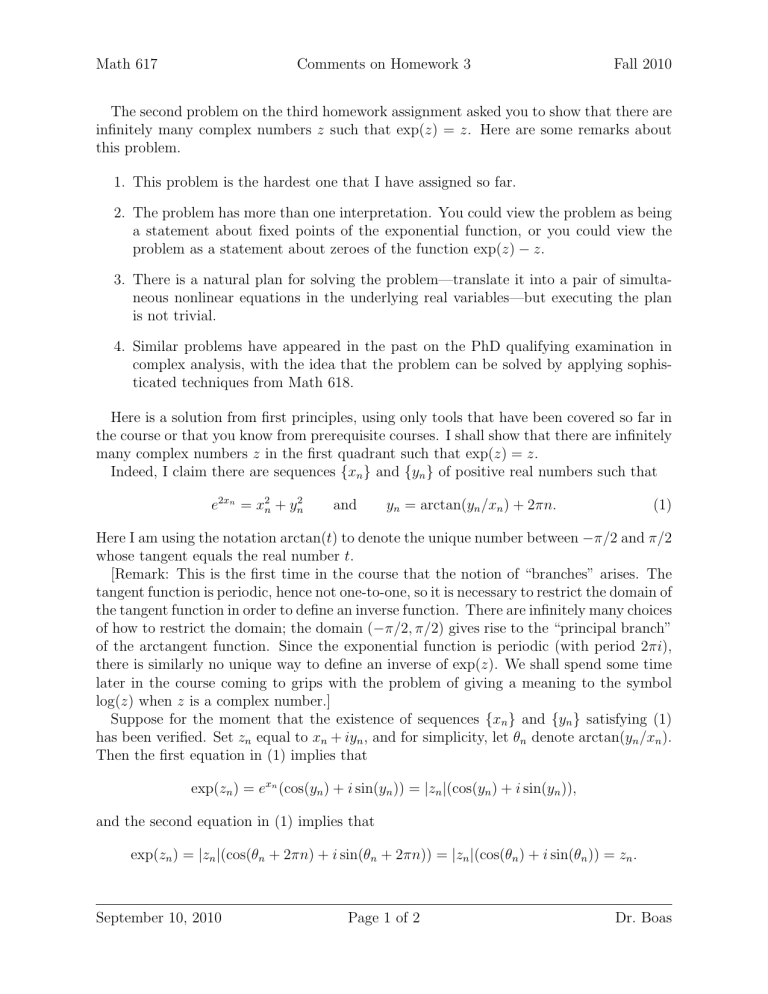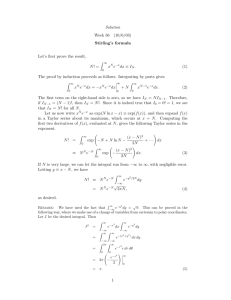Math 617 Comments on Homework 3 Fall 2010
advertisement

Math 617
Comments on Homework 3
Fall 2010
The second problem on the third homework assignment asked you to show that there are
infinitely many complex numbers z such that exp(z) = z. Here are some remarks about
this problem.
1. This problem is the hardest one that I have assigned so far.
2. The problem has more than one interpretation. You could view the problem as being
a statement about fixed points of the exponential function, or you could view the
problem as a statement about zeroes of the function exp(z) − z.
3. There is a natural plan for solving the problem—translate it into a pair of simultaneous nonlinear equations in the underlying real variables—but executing the plan
is not trivial.
4. Similar problems have appeared in the past on the PhD qualifying examination in
complex analysis, with the idea that the problem can be solved by applying sophisticated techniques from Math 618.
Here is a solution from first principles, using only tools that have been covered so far in
the course or that you know from prerequisite courses. I shall show that there are infinitely
many complex numbers z in the first quadrant such that exp(z) = z.
Indeed, I claim there are sequences {xn } and {yn } of positive real numbers such that
e2xn = x2n + yn2
and
yn = arctan(yn /xn ) + 2πn.
(1)
Here I am using the notation arctan(t) to denote the unique number between −π/2 and π/2
whose tangent equals the real number t.
[Remark: This is the first time in the course that the notion of “branches” arises. The
tangent function is periodic, hence not one-to-one, so it is necessary to restrict the domain of
the tangent function in order to define an inverse function. There are infinitely many choices
of how to restrict the domain; the domain (−π/2, π/2) gives rise to the “principal branch”
of the arctangent function. Since the exponential function is periodic (with period 2πi),
there is similarly no unique way to define an inverse of exp(z). We shall spend some time
later in the course coming to grips with the problem of giving a meaning to the symbol
log(z) when z is a complex number.]
Suppose for the moment that the existence of sequences {xn } and {yn } satisfying (1)
has been verified. Set zn equal to xn + iyn , and for simplicity, let θn denote arctan(yn /xn ).
Then the first equation in (1) implies that
exp(zn ) = exn (cos(yn ) + i sin(yn )) = |zn |(cos(yn ) + i sin(yn )),
and the second equation in (1) implies that
exp(zn ) = |zn |(cos(θn + 2πn) + i sin(θn + 2πn)) = |zn |(cos(θn ) + i sin(θn )) = zn .
September 10, 2010
Page 1 of 2
Dr. Boas
Math 617
Comments on Homework 3
Fall 2010
Notice that the complex numbers zn for different values of n are distinct, for |yj − yk | > π
when j 6= k. Thus verifying the existence of the sequences {xn } and {yn } will solve the
problem.
To make this verification, I first make the subsidiary claim that for every positive integer n, there exists a positive real number xn such that
p
p
e2xn − x2n − arctan(x−1
e2xn − x2n ) = 2πn.
(2)
n
Notice that ex > x when x is a real number, hence e2x − x2 > 0, so the expression
p
e2xn − x2n represents a well-defined positive real number, call it yn . For this choice of yn ,
it is evident that (2) implies (1).
Finally, to verify the existence of a number xn satisfying (2), observe that the function
√
√
e2x − x2 − arctan(x−1 e2x − x2 )
(3)
is a continuous function of x when x > 0 that has a one-sided limit as x → 0+ equal to
the negative value 1 − 12 π. Moreover, this function tends to ∞ when x → ∞ (because the
expression e2x − x2 blows up, while the arctangent function stays bounded above by π/2).
The intermediate-value theorem from real calculus implies that the function (3) has every
positive real number in its range. Consequently, there is a positive real number xn at
which the function (3) takes the value 2πn. This conclusion completes the verification of
the subsidiary claim and also completes the solution of the problem.
Remarks:
1. Notice that the preceding discussion can be turned into a method for computing solutions numerically. All that is needed is to approximate the values of the function (3).
2. A more sophisticated solution of the problem, using tools from Math 618 that you do
not know yet, could go as follows. Suppose if possible that the function exp(z) − z
has only a finite number of zeroes (conceivably none at all). These zeroes can be
factored out to write exp(z) − z as the product of a polynomial p(z) and a zero-free
entire function. Now a zero-free entire function has an entire logarithm. In other
words, there is an entire function f (z) such that
exp(z) − z = p(z) exp(f (z)).
(4)
Modifying the polynomial p by a constant factor shows that there is no loss of generality in supposing that f (0) = 0. Hadamard’s factorization theorem for entire
functions of finite order implies that f (z) must have the form az for some complex
number a. Considering growth rates of the two sides of (4) as z → ±∞ and as
z → ±i∞ shows that a must equal 1. Dividing both sides of (4) by exp(z) then
shows that the function z exp(−z) is equal to a polynomial. Evidently that polynomial must take the value 0 at 0, and dividing out the factor of z shows that exp(−z)
itself is a polynomial, an absurd conclusion. Thus the assumption that the function
exp(z) − z has only a finite number of zeroes leads to a contradiction.
September 10, 2010
Page 2 of 2
Dr. Boas






